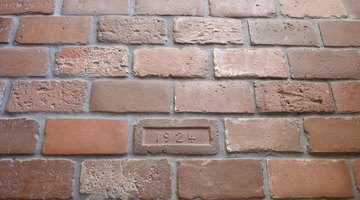How to Build a Brick Ceiling
Brick construction is both durable and traditional, making it a good option for many homes. Brick ceilings present special challenges because of their weight. However, if you have an older home or want a specific look, a brick ceiling is possible using one of several construction options.

Traditional Brick Ceilings
The traditional method for building a brick ceiling involves the construction of a vaulted ceiling that supports its own weight. Vaulted ceilings are composed of bricks, stone and mortar. They are expensive and time-consuming projects, requiring an interior scaffold to provide the ceiling form and a great deal of masonry work to ensure that the ceiling is strong enough to stand on its own. While vaulted brick ceilings can be found in older buildings, they are not common in residential structures and not practical for most homeowners.
Brick Veneer
Brick veneer ceilings offer a simpler, more affordable option. Brick veneer uses a thin layer of cut brick with only a fraction of the weight of a traditional brick. Brick veneer is installed with special adhesive or lime-based mortar, imparting a look that is indistinguishable from a full brick ceiling. As long as the mortar is mixed properly, and the ceiling frame is engineered to support its weight, the brick veneer can remain in place indefinitely.
Barrel Ceilings
Brick veneer can be installed on a barrel ceiling, which is a curved ceiling that resembles a dome or rounded tunnel interior. Barrel ceilings are most easily built using kits, which utilize curved lumber for structural framing. The entire ceiling structure sits beneath the home's roof framing, meaning the ceiling framework only supports the weight of the ceiling and not the roof above. Once the ceiling frame is in place, it is suitable for plastering and adding brick veneer. Any custom framing or kit used to create the ceiling frame must be rated to support a backing surface, such as drywall or plaster, and the brick veneer finish. Consult kit manufacturers for installation specifications.
Alternatives
There are also several alternatives to authentic brick ceilings that bring a faux brick look to your ceiling without the weight or cost of installing bricks or brick veneer. Faux brick ceilings can take the form of painted drywall or carved foam. Another option is installing a plaster ceiling and scoring it with a trowel to give it a brickwork pattern, which can be painted when dry to resemble any type of brick.
The Drip Cap
- Brick construction is both durable and traditional, making it a good option for many homes.
- However, if you have an older home or want a specific look, a brick ceiling is possible using one of several construction options.
- Vaulted ceilings are composed of bricks, stone and mortar.
- Brick veneer is installed with special adhesive or lime-based mortar, imparting a look that is indistinguishable from a full brick ceiling.
- Any custom framing or kit used to create the ceiling frame must be rated to support a backing surface, such as drywall or plaster, and the brick veneer finish.
References
Resources
Photo Credits
- Thinkstock Images/Comstock/Getty Images
- Thinkstock Images/Comstock/Getty Images
More Articles



